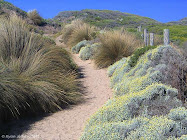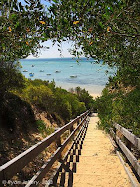 One of my aims is to preserve Rye’s history, and so it was with alarm I learned of the ‘For Sale’ signs on three properties on the western corner of Point Nepean Road and Dundas Street, all owned by the same family. I have no objection of course to these people selling these properties – after all they have been owned by them for many years – 2463 for 46 years and The Palms for 35 years.
One of my aims is to preserve Rye’s history, and so it was with alarm I learned of the ‘For Sale’ signs on three properties on the western corner of Point Nepean Road and Dundas Street, all owned by the same family. I have no objection of course to these people selling these properties – after all they have been owned by them for many years – 2463 for 46 years and The Palms for 35 years. This area is prime residential land and the disappearance of these two houses in any circumstance would continue the loss of Rye’s remaining character and charm as a seaside town.
Both houses have a long history, over 90 years. Built around 1914 when Point Nepean Road was still known as The Esplanade, the first house at 2463 was for over 60 years the school headmaster’s residence. Built by an early Rye builder Ted Baker, it was originally on the corner block, and moved back many years ago to where it is today. It was rented by different families including the Tylers who came in 1915. The owner of the Pier Store, Stephen Beecher, bought it in 1919 then sold to the Education Department in 1921 when the residence beside the school became unfit for habitation. These two blocks were sold to the present owner in 1983.
The department sold the back sections of the two blocks in 1962 to ‘The Queen’ for the Rye Police Station and residence. This residence is the one sold recently as No 2 Dundas Street.
‘The Palms’ property originally went through to Maori Street. This house with its palms has a character all of its own. James Rowley of the old Rye family owned it from 1923 and rented it to the Hall family in the 1920s. One of their daughters was a teacher at the school, and a son wrote about the early history of Rye. Jim Rowley sold to Mr and Mrs Palmer in 1930 – they had The Palm Mattress factory. The frontage to Maori Street sold in 1937. Visitors to this house included a nephew – Graham Kennedy. Jim Gerald the comedian and the ‘dame’ in the pantomimes, a brother in law of Mrs Palmer lived there for a time. The present owners bought it in 1973.
 These well maintained and attractive properties formed the eastern end of the Crown Grant of 67 acres in 1869 to Thomas Monahan of St Kilda for 14 pds 19/8. Extending to White Cliffs and back to Melbourne Road, it was transferred to John Wallace in 1901. In 1904 the Danish Anders Andersen, Rye Storekeeper, bought the whole area, selling to William L Thompson in 1912. He then proceeded to subdivide and sell off the various blocks. His family still owns ‘Bimblehurst’ at the western end of this original grant.
These well maintained and attractive properties formed the eastern end of the Crown Grant of 67 acres in 1869 to Thomas Monahan of St Kilda for 14 pds 19/8. Extending to White Cliffs and back to Melbourne Road, it was transferred to John Wallace in 1901. In 1904 the Danish Anders Andersen, Rye Storekeeper, bought the whole area, selling to William L Thompson in 1912. He then proceeded to subdivide and sell off the various blocks. His family still owns ‘Bimblehurst’ at the western end of this original grant.Although a takeaway food business can build in a residential area with access to a main road, the Mornington Peninsula Shire Council will determine if this multi national fast food company goes ahead with its plans. In the last edition of ‘Peninsula News’ there was an article ‘Demolition v Heritage – Keeping the best from our past’. It states that the planning system provides a means to identify and protect these special places.
Heritage checks are taken before a demolition permit is issued. Questions to be answered are: Is this house one of the oldest in the area, are there many places like this left in the town, was it once used by or lived in by someone well known?
Finally, the question we ask is: Does the commercial area of Rye need to be extended over Dundas Street. It is a very heavy traffic area already - another problem in the town.
This proposal makes me more determined to identify all the places in Rye which have historical significance.





No comments:
Post a Comment